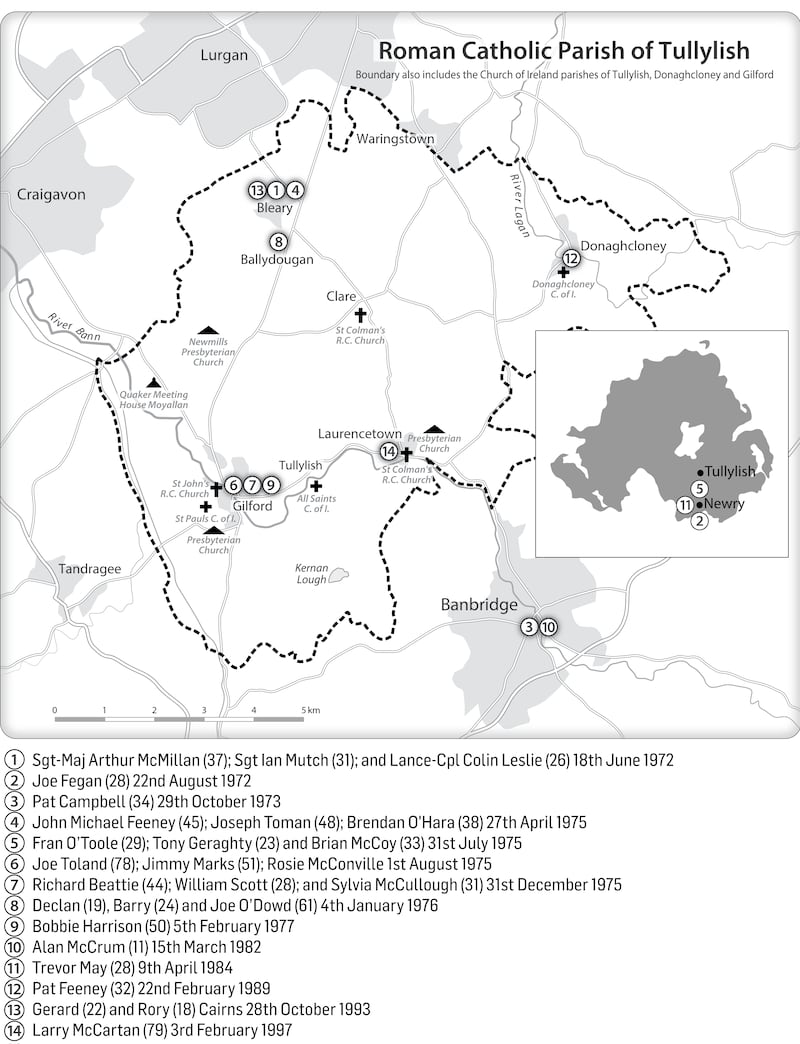Images of abandonment and dereliction proliferate in and around my home parish of Tullylish in Co Down, which straddles the river Bann as it meanders from Banbridge to Portadown.
It is hard to believe that this slow-moving, shallow river once powered a dozen linen mills, which employed thousands in the industry’s heyday. It is equally difficult to credit that the quiet villages and rural townlands that make up the parish were disfigured by decades of sectarian and political violence.
In Dirty Linen, I tell the story of the Troubles in my home place, which lies at the heart of both the Linen Triangle and the Murder Triangle, where loyalists colluded with members of the security forces to kill Catholic civilians and republicans waged indiscriminate war, leaving Catholic and Protestant victims in their wake.
Gilford, a mill village without a mill, is a shadow of itself, Mill Street’s blocked-up shop windows decorated not with artist’s impressions of imminent redevelopment but sepia reproductions of its bustling, prosperous industrial past. The disused mill itself is six storeys high, all empty. The Pheasant Lodge was once the Central Bar. On New Year’s Eve, 1975, a no-warning INLA bomb killed three Protestant civilians.
RM Block
In Bleary, a laneway with an overgrown Mohican of grass up the middle and an open gate almost swallowed up by a hedge leads to a field that lies not so much fallow as forgotten. Here once stood a cottage abandoned after its occupant fled South after being released from internment. An IRA booby-trap bomb killed three soldiers here in 1972.
Two lonely benches overlook Kernan Lough, where Joe Toman, a joiner, once fished in a boat he built himself, and Jimmy Feeney also sought solace fishing in his boat. Jimmy won an All-Ireland senior boxing title in the National Stadium in 1975, then two days later witnessed UVF gunmen murder his father, John Michael, and Joe in Bleary Darts Club, an old weaver’s cottage. He died by suicide in 2007. Only grass grows where the clubhouse stood. These were our killing fields.

Noel O’Dowd gazes at the ruins of the livingroom of his family’s farmhouse in Ballydougan, where his brothers Barry and Declan and uncle Joe were murdered by loyalists in January 1976. His old home has lain empty since the family abandoned it that summer, his mother terrified that the killers might return. Erected by Eamon Cairns, whose sons Gerard and Rory were murdered in their home in 1993, a few hundred yards from the O’Dowds’, a memorial in Clare chapel’s graveyard lists local victims of the conflict.
Cars pass under a pretty canopy of tree leaves just outside Gilford, where in 1975 a minibus carrying women and pensioners home from bingo was ambushed, killing a passenger instantly, two others dying later of their injuries. Although the victims were Catholic, ballistics evidence suggests it was an IRA attack.
An Orange arch dominates the high street in my birthplace, Banbridge, colonising what should be a shared civic space. A clock marks time above a jeweller’s nearby, where 11-year-old Protestant schoolboy Alan McCrum was murdered in a no-warning IRA bomb in 1982 that also maimed many others.
In Seapatrick, metal silhouettes of workers line the lane down to Hayes’s mill. All that’s left is a redbrick gable, whose ghost sign seems to say No King. A housing estate across the road has a shrine-like mural to the UVF, which killed more than a dozen Catholics locally.
The mill beside the river Lagan in Donaghcloney, which produced fine linen for Concorde and the Titanic, has been demolished, bar one bricked-up facade propped up with girders. “Keep Out! Dangerous Building” says the sign. The UVF murdered a Catholic nightwatchman, my neighbour Pat Feeney, here in 1989, set up by a colleague. Graffiti in the toilets the next day read: UVF 2 Feeneys 0, a cruel reference to his uncle John Michael.
Dirty Linen: The Troubles in My Home Place (Merrion Press) is out now in paperback. In memory of my mother, Marie Doyle (04/08/1940-05/08/2024), who inspired it.





















